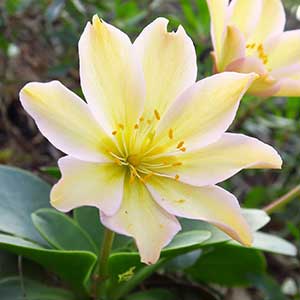Cistanthe tweedyi
(synonym of Lewisiopsis tweedyi)
Tweedy's bitterroot, Tweedy's lewisia, Tweedy's pussypaws
1 or more from each rosette, 10–20 cm, bracts scattered proximally, ovate-lanceolate, scarious.
basal, in loose rosettes;
blade elliptic-lanceolate to ovate or oblanceolate, narrowing to broad petiole, 6–15 cm.
racemose, 1–5(–8)-flowered.
pedicellate;
sepals broadly ovate, 9–10 mm, scarious;
petals 7–9(–12), salmon-pink to yellowish, rarely white, 25–40 mm;
stamens 10–23, anther yellow;
style present;
stigmas 3;
pedicel 20–60 mm.
ovoid, 7–10 mm, dehiscence circumscissile near base;
valves 3–4, splitting from base toward apex.
12–35, dark brownish red, suborbicular to reniform, 2 mm, not shiny, warty, strophiolate.
= 46, 92.
Cistanthe tweedyi
Of conservation concern.
(Discussion copyrighted by Flora of North America; reprinted with permission.)


